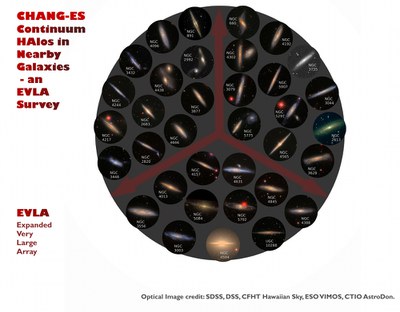Continuum Halos in Nearby Galaxies - an EVLA Survey (CHANG-ES)
 Continuum Halos in Nearby Galaxies - an EVLA Survey (CHANG-ES), was awarded 405 hours of observing time in the B, C and D array configurations. The survey aims to measure radio continuum emission of 35 nearby edge-on galaxies in C band (6 GHz) and L band (1.4 GHz). The edge-on inclination of the galaxies makes it possible to probe the structure and physics of disk-halo outflows. With 3 arrays of observations (B, C, and D), we will be able to examine, in detail, the disk-halo interface, as well as the larger scale halos that surround galaxies.
Continuum Halos in Nearby Galaxies - an EVLA Survey (CHANG-ES), was awarded 405 hours of observing time in the B, C and D array configurations. The survey aims to measure radio continuum emission of 35 nearby edge-on galaxies in C band (6 GHz) and L band (1.4 GHz). The edge-on inclination of the galaxies makes it possible to probe the structure and physics of disk-halo outflows. With 3 arrays of observations (B, C, and D), we will be able to examine, in detail, the disk-halo interface, as well as the larger scale halos that surround galaxies.
Gaseous halos, as revealed in many tracers (neutral and molecular hydrogen, ionized gas, hot plasma, high energetic cosmic rays, magnetic fields and other molecules), are not distributed smoothly, but show structure on many scales, an indication that halos are dynamic entities and that there is ‘communication’ between the galaxy and its surroundings via gas transfer. Although it is not yet clear how and to what extent such transfer occurs, there are indications that the halo could be related to in-disk star formation activity and that cosmic rays and magnetic fields are important ingredients.
The CHANG-ES observations will be able to answer questions about the prevalence, extent and physics of such outflows and allow us to map the cosmic rays and magnetic fields with unprecedented sensitivity and detail. Because of the sufficiently large and coherent sample, for the first time, we will be able to quantify how magnetic fields and cosmic rays in halos correlate with the properties of the galaxy and the galaxy environment.
Specific science drivers include: The origin of halos and their physical conditions, the nature, prevalence, and origin of lagging halos, cosmic ray transport and outflowing wind velocity, the nature of magnetic fields in the context of galactic dynamo models, and the origin of the far infrared - radio continuum relation.
The CHANG-ES consortium:
- Judith Irwin, Queen's University, Kingston, Canada
- Rainer Beck, Max-Planck-Institut für Radioastronomie, Bonn, Germany
- Robert Benjamin, University of Wisconsin at Whitewater, USA
- Ralf-Jürgen Dettmar, Ruhr-Universität Bochum, Germany
- Jayanne English, University of Manitoba, Canada
- George Heald, Netherlands Institute for Radio Astronomy, Dwingeloo, The Netherlands
- Richard Henriksen, Queen's University, Kingston, Canada
- Megan Johnson, NRAO, Greenbank, WV, USA
- Amanda Kepley, NRAO, Greenbank, WV, USA
- Marita Krause, Max-Planck-Institut für Radioastronomie, Bonn, Germany
- Jiang-Tao Li, CEA, Saclay, France
- Arpad Miskolczi, Ruhr-Universität Bochum, Germany
- Silvia Carolina Mora, Max-Planck-Institut für Radioastronomie, Bonn, Germany
- Eric Murphy, Spitzer Science Center, Caltech, Pasadena, USA
- Tom Oosterloo, Netherlands Institute for Radio Astronomy, Dwingeloo, The Netherlands
- Elena Orlando, Stanford University, Stanford, USA
- Troy Porter, Stanford University, Palo Alto, USA
- Richard Rand, University of New Mexico, Albuquerque, USA
- D. J. Saikia, National Centre for Radio Astrophysics, Pune, India
- Philip Schmidt, Max-Planck-Institut für Radioastronomie, Bonn, Germany
- Yelena Stein, Ruhr-Universität Bochum, Germany
- Andrew Strong, Max-Planck-Institut für extraterrestrische Physik, Garching, Germany
- Rene Walterbos, New Mexico State University, Las Cruces, USA
- Daniel Wang, University of Massachusetts, Amherst, USA
- Theresa Wiegert, Queen's University, Kingston, Canada
Acknowledgements:
Many thanks to the National Radio Astronomy Observatory for the allotment of observing time on the EVLA and to the NRAO staff for assistance with the data observations and reductions.




Connect with NRAO